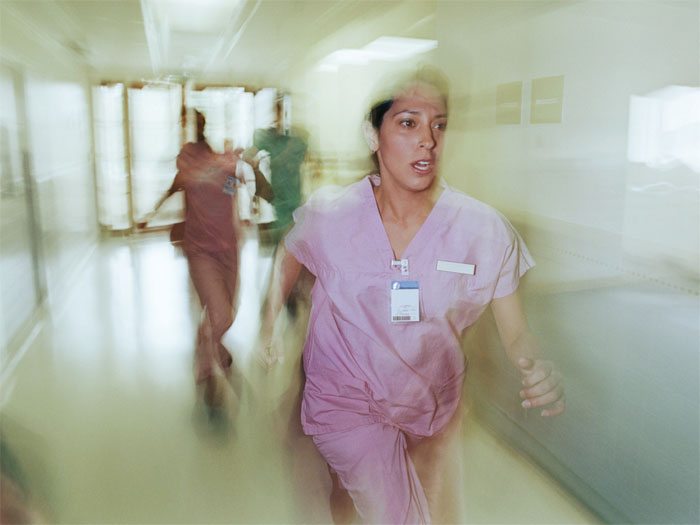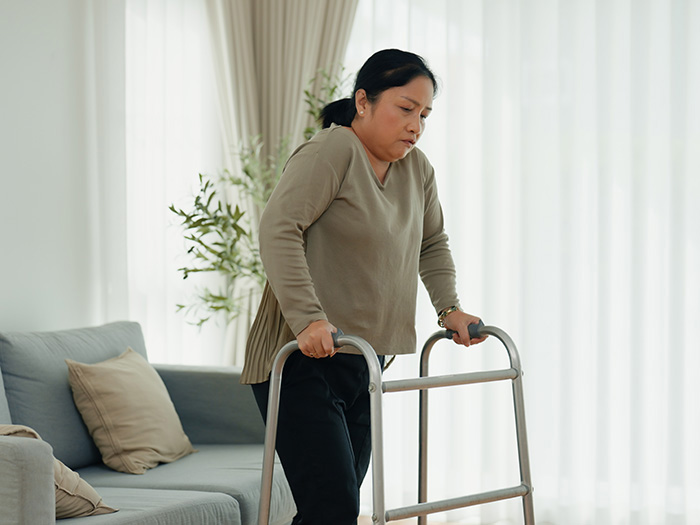Safety
Nurse, Protect Thyself

Charged with providing a safe environment for their patients, nurses themselves work under conditions that threaten their safety and well-being. One key factor is that the field’s ongoing labor shortage may exacerbate the stress of working nurses, as more medical responsibilities are shifted from doctors to nurses.
Other factors are that the majority of nurses are in their 40s and 50s and are more vulnerable to back and other injuries from pushing heavy medical equipment and assisting overweight patients. Nurses are also prone to drug and alcohol dependency, as some self-medicate for stress.
A 2012 Aon study found that these workplace hazards contribute to nearly $2 billion in nurse-related workers’ compensation claims annually.
Creating a safer workplace for nurses depends on a combination of education, technology, and behavior change, according to experts. It must be driven at the executive level and influenced by incentives from insurance companies.
The health care industry has had mixed success in controlling workplace injuries.
On the positive side, Mark Noonan, a broker at Integro, said fewer claims are filed these days for bloodborne pathogen infections and slips and falls, thanks to disciplined health care sanitation and training policies.
The numbers bear out his observation: The frequency of health care workers’ compensation claims has decreased slowly but consistently.
But nursing claim severity, including medical, indemnity and defense costs, has increased at a rate of 2 percent per year, according to Aon.
The home heath market, which will grow even larger as the 2010 Affordable Care Act takes force, raises safety questions for off-facility nurses, said Lori Severson, loss control consultant at Lockton.
“The safety issues raise the hairs on my neck,” she said. Homes are an uncontrolled environment not subject to OSHA inspections.
“At this point, we can hope families will comply with a safety checklist about dogs, sidewalks and mold,” she said.
Patient management injuries — including those from turning and moving patients, and from slips, trips and falls — each account for about 30 percent of claims payouts, said Tim Portale, chief safety and security officer at Nashville-based Hospital Corp. of America. Materials handling accounts for another 8 percent, and workplace violence for 7 percent.
Nursing injuries resulting in lost work time account for only 10 percent to 20 percent of claims, but they account for 85 percent of workers’ comp payouts in that field, according to Portale.
“Typically, health care safety programs concentrate on those high-value claims,” he said. HCA owns 162 hospitals and 113 freestanding surgery centers in 20 states and England, and it extrapolates the above statistics from its own experience.
Back Injuries, Scourge of Nurses
Back injuries, the second-leading occupational injury in the United States across professions, are the single most costly injury for nurses, according to the National Institute for Occupational Safety and Health.
America’s obesity epidemic, said Kevin Gabhart, managing director at Beecher Carlson in Brentwood, Tenn., affects more than patients, especially on bariatric floors. “Imagine a 150-pound nurse lifting a 300-pound patient,” he said. “The cumulative effect of patient handling takes a toll on their skeletons and soft tissue.”
Since most nurses are in their 40s and 50s, many suffer injuries related to lifting, pushing and carrying heavy weights, Gabhart said.
“Treatment for a 50-year-old nurse costs more than treatment for a 20-year-old with the same injury.”
According to the American Nursing Association, 38 percent of nurses report job-related back pain severe enough to require leave from work, 12 percent leave nursing because of it, and 20 percent change to a different role within the profession.
That doesn’t include the majority of nurses, said Noonan, who simply accept pain as an occupational hazard and use over-the-counter analgesics until the pain becomes unbearable.
“Nurses are a pretty stoic cohort,” he said.
A 2011 American Nurse Today article, however, suggested 10 percent to 15 percent of nurses may be impaired or in recovery from alcohol or drug addiction, mostly the result of self-medication for pain relief.
The ANA agreed that manual patient handling is responsible for nurses’ musculoskeletal disorders and recommended assistive equipment and devices, such as lifting machines, to prevent them.
“The benefits of safe patient handling are well documented,” said Jaime Murphy Dawson, senior policy analyst at the ANA.
“Proper use of technology and manual techniques produces great savings in suffering and workers’ comp claims,” she said.
A 2004 Centers for Disease Control and Prevention study of a self-insured hospital found the cost of lifting equipment and worker training paid for itself in reduced workers’ compensation expenses in slightly less than three years. The return on investment is quicker, the study found, if savings in indirect costs (lost wages, cost of hiring and retraining workers, etc.) are included.
However, many hospitals don’t have the budget to buy enough lifts, which can cost thousands of dollars apiece.
Even lifts aren’t the perfect solution, said the ANA’s Dawson. Back injuries have declined as more lifts have come on line, but shoulder injuries are on the rise from nurses pushing the heavy machinery from room to room.
Some new hospitals are designed with ceiling and floor tracks, ANA’s “gold standard” of hospital design, but the cost of retrofitting existing facilities is often prohibitive.
Nursing schools are responding to the risk of injuries with beefed-up clinical curricula. Temple University’s baccalaureate nursing program, for example, tests students in safe patient handling every semester rather than the semester in which the procedures are first taught. The program increased its required clinical hours by 30 percent five years ago.
In June the ANA released professional standards for safe patient handling and mobility that includes contributions from architects, ergonomists, administrators, and health care providers.
Stress and Burnout
Although back injuries account for more workers’ compensation dollars than any other single category of claim, nurses themselves are more concerned about stress. The ANA survey found a majority of nurses are concerned about health effects from stress and overwork.
Long hours, sensory overload from medical device alarms, too many patients, and high accountability for an excess of life-or-death decisions contribute to the stress load. “Nurses juggle two, three, four chainsaws at a time,” said Integro’s Noonan.
“Pressure to do more with less is a reality in the present health care system, and it leads to accidents,” he said.
Workplace violence, including harassment, is another factor.
Although their appearance makes for good television drama, violent patients with weapons in the emergency room are few and far between, said Pamela Popp, executive vice president and chief risk officer at Western Litigation, a law firm representing health care providers.
Abuse of nurses by an unexpected slice of the population — seniors — is rising, however.
“Self-control weakens with age and dementia,” said Noonan, “and nurses are on the front lines, often delivering bad news to patients and their frightened families.”
Nurse-on-nurse bullying and physician bullying of nurses are also workplace realities.
“Nurses’ historical roles as handmaidens to doctors created a culture where harassment and intimidation became normal,” Popp said. She said such abuse compromises patient care and contributes to a hostile workplace for some nurses.
Remediation starts at the beginning, with training for both nurses and doctors, and continues through on-the-job training and licensing standards, according to a 2002 American Journal of Medical Quality study. Both medical and nursing schools include behavioral performance in their curricula.
“We teach conflict resolution skills,” said Karen Desjardins, assistant professor of clinical nursing and assistant dean at the Columbia University School of Nursing. “In times of conflict, our students know how to respond without escalating the hostility.”
Creating an internal culture that prevents a hostile environment — and its attendant stress-related workers’ compensation claims — is a challenge, Popp said.
“Only real training can reverse the culture of blame that prevails in health care now,” she said.
Currently, said David Marx, CEO of Outcome Ingenuity, a not-for-profit that supports health care system safety, most U.S. hospitals have an overly punitive environment that penalizes people for making mistakes rather than seizing an opportunity for educating workers.
The culture of blame applies equally to needle disposal and safe patient handling, for example, as to behavioral choices.
“The ‘no harm, no foul’ culture encourages risky behavior,” he said. “We turn a blind eye to risk until harm occurs, and then we whack the offender.”
Instead of focusing on events, errors and outcomes, Marx said, health care organizations should focus on risk, system design and behavioral choices.
“When they don’t fear reprisal, nurses are more likely to speak up if they, or their colleagues, slip into risky behavior,” he said. “Then the hospital can change the practice.”










